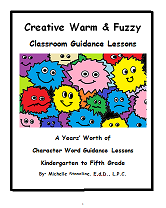Helping Kids Behave
Page 2
¨ Have a neat clean physical environment.
¨ Vary your teaching style and techniques to fit the changing needs of your students.
¨ Be efficient. Lessons begin and end on time. Lesson plans have a purpose and measurable outcomes.
¨ Check to be sure that students understand as you go along and make adjustments.
¨ Listen actively; look at students, lean forward, paraphrase what they say.
Chapman (2000) gives eight steps to good listening
1) Maintain eye contact when the other person is talking.
2) Don’t do anything else at the same time.
3) Listen for feelings.
4) Observe body language
5) Refuse to interrupt. The average person listens for only 17 seconds before interrupting.
6) Ask reflective questions.
7) Express understanding.
8) Ask permission to share your perspective.
¨ Make sure your tone of voice matches your message. Be aware of how loud or soft you speak. Soft and slow is more likely to calm an angry student.
¨ Use touch to show warmth. By patting a student on the back or even shaking hands.
¨ Use eye contact and body language. Watch the student’s facial expressions. Also smile, nod your head and keep your hands relaxed.
¨ Try taking the child’s perspective; this shows understanding.
¨ Let the kid in you out to play. This can teach valuable lessons such as sharing, showing respect, and following rules.
¨ Use your sense of humor. This gives kids a break from stress. It can also insulate you from negative feelings that can get the best of you.
¨ Try to empathize or share the student’s feelings and situation. However, be sure students understand that feeling bad is not an excuse for misbehavior.
¨ Praise students for good behavior. Be specific at first and then move to being more general. Be brief but enthusiastic. Be sure to give praise immediately when possible but be appropriate. Wait if it would embarrass the student.
Another component of building relationships involves how to show you care. Chapman(1992) relates an experiment he tried. He had the wife speak the husbands love language without having the husband reciprocate for one month. The result – the husband began to respond more positively to the wife and then wanted to learn her language.
This same tactic was also tried with children and found to work. This was in chapter 12 “Loving the unlovely”. Carl Rogers called it unconditional positive regard. Chapman calls it love. It means the same thing. In the author’s experience many children with behavior problems don’t feel loved or that anyone even cares about them.
Anger is always a secondary emotion. It is really caused by hurt, pain, embarrassment, neglect etc. Ron Huxley in his article “”Big Boys Do Cry: Helping Our Sons Increase Their Emotional IQ”(Parenting toolbox), points out that males are taught it is OK to show only one emotion, Anger.
This results in an emotional funnel; every emotion, sadness, fear and frustration is translated into one emotion: Anger! How does one discover what underlies the anger? Joyce Divinyi of, The Human Connection, points out in her workshop, that most feelings that result in anger are intense and vulnerable in nature.
She further states that more obvious feelings like anger are used to mask the vulnerable feelings (Divinyi, 2000). She advises that you think about the last time you were angry and then consider what you were FEELING under the anger. A checklist that she finds helpful is found in appendix C.
She further notes that behavior is a consequence of feelings and needs. Until these feelings and needs are addressed, the behavior will not change. She also notes that behavior that is unacceptable in the workplace is unacceptable in the classroom. The author’s experience is most people need a concrete goal to be motivated.
Most children and their parents do not see education as a goal in and of itself. In their minds if you are not preparing them to make a living, you are wasting their time. Helping children work through these feelings is part of caring and shows caring. It also is part of getting them ready to hold down a job.
If you are still not convinced that caring counts then refer to “Warning!: Understanding and Responding to Destructive Youth Behaviors.’’ (GEMA, 2000) This workshop by the Georgia Emergency Management Agency comes to the conclusion that only 15% of children get the care they need at home. By that they mean caring and support, positive expectations, involvement, and participation in their lives.
The good news is one person who cares can make a difference. “… For children who are used to thinking of themselves as stupid, or not worth talking to or deserving rape, and beatings, a GOOD teacher can provide an astonishing revelation.
A good teacher can give a child at least a chance to feel, ‘s/he thinks I’m worth something, maybe I am.”(GEMA, 2000) Caring won’t solve everything but it will help. Even the worst behaved students this author ever taught behaved better once they knew someone cared. And self-fulfilling prophecies work both ways.
So, how do you show that you care. According to Chapman (199) Chapman &Campbell(1997) and Chapman (2000), the five love languages or ways to show you care are:
¨ Affirming words - eye and body contact, tone of voice, humor praise
¨ Gifts-physical environment, instruction, humor
¨ Acts of service - instructional help, assistance, etc.
¨ Quality time - listening, understanding, empathy, play humor
¨ Physical touch- touching others and being touched by others
Helping Kids Behave Page 3 Link Below:
Helping Kids Behave Part Three Creative Counseling 101 Home Page
Disclaimer: This website and its content is intended for trained licensed mental health professionals and school certified mental health professionals to use for their clients / students at their own discretion.
*If you ignore the disclaimer above are using these techniques on yourself and you feel any discomfort or upset it is highly suggested that you seek out a licensed mental health professional immediately.
"Beyond Art Therapy" is the concept from Dr. Stangline that combines all creative fields in therapy. It is not the traditional "art therapy" but goes beyond to include sand tray therapy, play therapy, mindfulness, meditation, color therapy, cognitive behavioral therapy, and a vast majority of other therapies.
For any other type of mental health emergency call your local 911 / Police Number immediately.
Dr. Stangline does not offer advice / suggestions to anyone who is not a professional mental health provider, or a student who is studying this field and has questions about mental health programs of study.
See our Exciting Selection of eBooks:
Award Winning:
Creative Counseling 101 eBook
Our Best Seller!
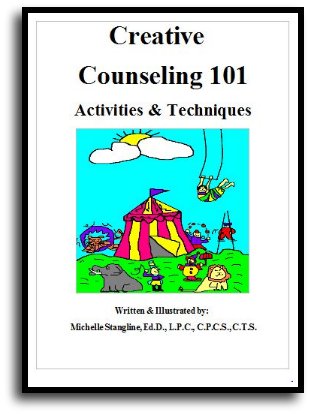
Step By Step Therapy:
Learn how to be a more Creative Therapist with the Book that started it all!
- Graduate School Counseling book used by hundreds of graduate counseling students!
- Includes full color reproducible worksheets with most activities.
- Winner of the Counselor Writer of the Year Award, 2011, Georgia Regional Award
Download Your Copy Today Only $39.95:
See Creative Counseling 101 eBook Information Here:
Get the Set
of all four
eBooks for only $98.95:
An incredible collection of how to do therapy eBooks!
A $159.80 Value,
You Save Over $60!
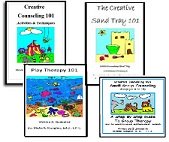
Get your complete set of the Creative Counseling 101.com eBooks by Dr. Michelle Stangline for only $98.95, that's less than $25.00 per eBook (Regular Price is $39.95 for each eBook.).
Your complete set includes:
- Creative Counseling 101
- Creative Group Counseling 101
- Creative Play Therapy 101
- Creative Sand Tray 101
For more information click the link below:
See Complete Set of eBooks For Sale Here:
New!!! "Beyond Art Therapy" 101 eBook
Over 300 pages of Beyond Art Therapy activities and techniques. Learn what I teach graduate counseling students!
See the link below for more information.
Only $39.95
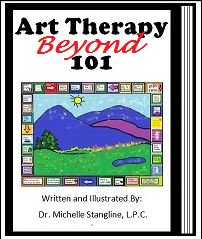
See More Invividual eBooks For Sale:
Sand Tray Therapy 101 eBook:
Learn how to do Sand Tray Therapy or enhance your skills.
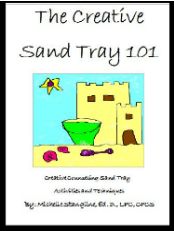
Play Therapy 101 eBook
Learn how to do play therapy or enhance your skills.
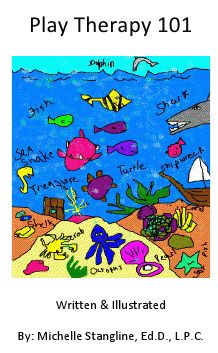
Small Group Counseling eBook For Sale:
Learn how to do creative group therapy and enhance your skills.
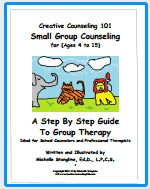
School Counselor Guidance Lesson & Social Stories eBook for sale:
Get a year's worth of school counselor guidance lessons with "Creative Warm & Fuzzy Classroom Guidance Lessons eBook". Introduce your students to the "Warm & Fuzzy Way". Click the link below for more information:
Warm & Fuzzy School Counselor Guidance Lessons eBook
